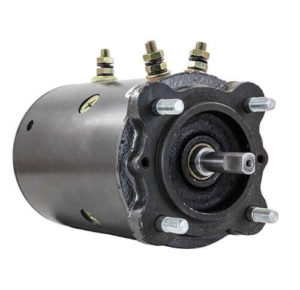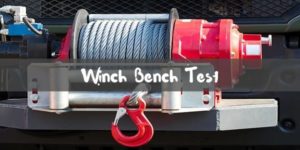Last Updated on June 28, 2021
It’s not always necessary that your winch will respond to you. The internal part of a winch can anytime encounter destructive circumstances. Gear, motor, solenoid, or any part can decide not to labor for you.
Before anything goes off or the warranty shows thumb down, it is that’s why essential for you to check your mechanical device. Well, how could you keep regular maintenance of it? The answer is simple, winch bench test.
By performing it, you can yourself confront the issue and solve it subsequently. For conserving pennies or preventing major collapses, this testing is efficient. To impose you with every part of the winch and the winch bench test, this article is carefully maintained.
Read till the last to beware of not-to-do with your winch. And learn how to deal with all its portions to prevent a giveaway of a handful of bucks to a professional.
Our Winch Guide & Reviews:
Quick Navigation
WHAT IS WINCH BENCH TEST?
A winch bench test means an in-depth analysis of a winch’s part. This examination generates a profound report about the working of a particular part. It signifies whether the part is functioning accurately or not.
Every part is dictated a certain task in the machine. If anyone’s ranking is not on par on the scale, the output gets affected. For this purpose, the scrutiny is of great importance.
You aren’t specialized, and your formal meetup with the winch is justified. That is why, before straightly acquainting you with the bench test, let’s familiarize you with the winch and its significant parts.
THE PARTS OF WINCH
A winch is a device that functions in releasing or tidying up the rope, wire, or cable. From aircraft to theaters, it displays exercising in numerous industries. It exists in a wide range and types, inclusive of Air winch, Lever winch, and Snubbing winch.
Mostly, it appears with the same parts in every type, and they are:
MOTOR

‘The monitor of a winch, which initiates the processes’
WINCH DRUM
‘A cylindrical shape on which the rope settles on.’
GEARS
‘The speed optimizer and leveling up part.’
BRAKING SYSTEM
‘It forces the system to shut off the working.’
SOLENOID
‘Electromagnetic switches of a winch that signals the machine to proceed.’
Rest are the additional parts with internal or tiny handlings.
SAFETY COMES FIRST…
After absorbing the article, if you feel that this a risky treatment or discover a need for a field expert, do not proceed yourself. A winch is a compact device. However, it could result in daunting fallouts. The apparatus, equipment, or even you can be at stake if the steps are not performed systematically.
That is why safety comes first!
BENCH TEST A WINCH-EXAMINATION OF EVERY FRAGMENT
You made motor the victim of your non-working winch and took it off. But, what if it’s not the hassle creator? For this fact, I suggest you strictly make notice of the little things initially.
Ahead of the Winch bench test for giant parts, the sensibility is scanning the upper layer issues. Perform the test on the tiny parts and inspect them. Here are the factors that are to be blamed and their simple solutions.
1. FAULTY SWITCH
The switches are the main lead of a machine. They hint the engine to launch working. If you get your winch sleepy and lifeless, a switch might be the trouble maker.
A winch cannot pull up the load and perform until it is indicated. Before doubting or presenting any other part in the court of inspection, focus on the switches. Place a fresh switch on the place of the former one. Give it a chance to perform.
Solution: During the test, if you track down that the switch has the curse, simply replace it. There is no comeback of the deceased materials other than replacement.
2. WIRINGS
You bought up a winch and got it plugged. But, it has a non-serious attitude, and lastly not functioning. In this case, maybe, the wiring is to be asked.
Bad wiring is the issue, sometimes. Perhaps, your newly subscribed winch has local wires, or it is flabby from inside. Better to consider this.
Solution: The immediate action you should take upon it is to read the manual. A manual is a mentor when no one else is there. In the case of wiring, there is a fine chance that you’ve integrated the wire in the wrong terminal.
3. TRIPPING OR LOW-GRADE CIRCUIT SERIES
Tripping and circuit breaking is a common affair. Anything, when overloaded, undergoes tripping. Your winch can drastically trip if it’s burdened or remains immersed in water.
If you think it’s not tripping the hidden cause behind winch’s inappropriate behavior, suspect the circuit. Maybe, the circuit seat is fragmented. Or, a short circuit is behind the breakage of the circuit. If the positive cable of the winch gets in association with the metal, short circuits take place.
Solution: In the first case, regarding tripping, resetting is the solution. There is a definite need for a wire to be altered in the latter event. If your problem does not culminate with the wire replacement, the issue is severe and from inside the winch.
4. CORROSION
In the winch bench test, corrosion is equally a culprit. At first, corrosion lessens the value of a product by bringing it to a moderate level. Finally, it ends up the potential of the winch and disrupts it.
If your wire or motor isn’t showing a standardized working efficacy, look for corrosion. Because it affects the performance of the machine.
Solution: To get rid of the corrosion on your motor, use grease. Grease the parts that are visible with corrosion. Treat them well with the lubricating oil, so that it remains free of corrosion for a healthy time. ‘REMEMBER,’ use a thin greasing oil!
As far as wiring is reflected with the corrosive activity, use sandpaper. Rub the terminals with sandpaper. Gently go with this process and be a smooth easing.
5. GEARS
There are two types of gears in the winch, sliding and mechanical. The machine’s rude working may be due to the lack of the support of sliding gears.
On the contrary, mechanical gears can also cause turmoil by deteriorating.
Solution: To pact with any sort of gear, the requisite is to take it out. When considering the sliding gear, make sure it is clean. The dirt, rust, and corrosion lead the sliding gear to frame a bad experience for you. Coat a thin layer of oil and grease again to hand over the gears, their operational skill.
The mechanical gears, however, once get damaged, are worthless. They only ask for a replacement and nothing else.
6. FUSE BLOWINGS OR SMASHED BRUSHES
You cannot underestimate a fuse. Just exceeding the limited load, a fuse detonates. The non-performance of the winch is also dependent upon the fuse.
Another tiny part that needs your attention in a winch bench test is a brush. In the motor of the winch resides the brushes. These brushes lose their capability within some time and get damaged. A winch may be lacking in the routine due to the devastating brushes in it.
Solution: If the blown-up fuse isn’t permitting your winch to present the required result, changing it would be a wise option. The brushes are dead and non-worthy to perform further in such a condition. The same option applies to fuse. Change it for good.
WINCH BENCH TEST FOR MAJOR PARTS
Wires checked, fuse-not an issue, switches are exquisitely performing, where is the error then? This has already flashed in your mind. The issues can be massive sometimes. I’ll magnify the winch here and will try to conclude the issue.
The solenoid and the motor will be rigorously questioned. And, their meticulous testing will be held.
HOW TO TEST A WINCH MOTOR?
The winch bench test for a motor is simple.
STEP 1:
Bring the motor on the counter of the check, eliminate the battery to terminal connections. Remove all the electrical components.
STEP 2:
Attach the ground terminal of the motor to the ground terminal of the battery by jumper cable.
STEP 3:
Link the terminal ‘F2’ to terminal ‘A.’ Connect the ‘positive terminal of the battery to the terminal ‘F1’ by jumper wire.
STEP 4:
Check the working of the motor. If it is alright, it will get out of its paralyze state and symbolize by running. And, if doesn’t come in motion, then it’s clearly out of order.
SOLUTION
If there is a clear no from your winch to set back into performance, this means it’s dead. You can then only trade a new motor to keep your winch working.
REMEMBER, focus on the wiring, brushes, and fuse prior to risking your money on a new motor. Maybe, the problem keeps sitting in there and not the motor.
HOW TO TEST A WINCH SOLENOID EASILY?
The solenoid pack comes 2 two ways, integrated or remote. They can sometimes confuse you about the winch’s functioning. To rest assured that the overall winch is fine and the problem is affiliated with the solenoid, perform a winch bench test for the solenoid.
These are the steps to execute the test:
STEP 1:
Detach the screws of the solenoid cover and the positive terminal of the battery. There is a fair possibility of the loose wire attachment if a clicking sound is evident during detachment.
STEP 2:
Turn off the winch. Make contact between the two big studs of solenoid and voltmeter. If the voltmeter confirms the 12 volts, the solenoid is well enough and working appropriately.
STEP 3:
Let the winch remain shut off during this test. Now, build contact with the two little studs of the solenoid and the voltmeter. Note the reading. If it’s 12 volts, the results aren’t accurate, and your solenoid has left its employment.
STEP 4:
To confirm the output, turn on the winch. Again interact the two little studs with the voltmeter. If the meter isn’t pulled up with reading, the operation of the solenoid isn’t to be doubted. And, if not, the solenoid has lost its force.
SOLUTION
The easiest way to get your winch to normalize is to substitute the defective pair of the solenoid.
REMEMBER, only change both the solenoid pairs if both aren’t active and able to perform. Otherwise, swapping only the faulty studs will be acceptable.
CONCLUSION
The winch bench test for every part is wind up. I have limelight over the triggering issues in the winch with their most straightforward solutions. If any day your winch gets persistent and shows inactivity, you can handle it yourself.
Do you have any additional defective winch part that is not addressed here? Comment down. I will surely get back to you with the most straightforward test and modest solutions.
People also asked…
- How can I wire my winch with a toggle switch?
- What are the steps to wire a winch without solenoid?
- Can I use a winch without remote?


I’m Daniel Galbreath, founder of OffRoadersWorld.
I spend my spare time writing on this website, OffRoaders World. I share my thoughts and reviews on different types of gears, share tips sometimes. This website is specially created and regularly updated basically to help other folks like me when I started to solve the various problems they face, specially when they go off-roading.

Is it safe?
Yes, if you do it right